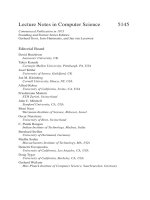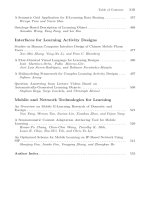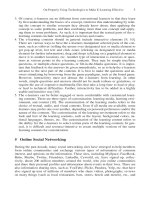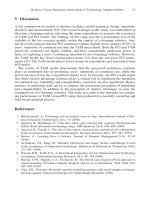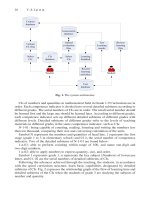Lecture Notes in Computer Science- P4 ppt
Bạn đang xem bản rút gọn của tài liệu. Xem và tải ngay bản đầy đủ của tài liệu tại đây (141.09 KB, 5 trang )
On Properly Using Technologies to Make E-Learning Effective 5
3. Of course, e-learners are no different from conventional learners in that they learn
by first understanding the basics of a concept, reinforce this understanding by relat-
ing the concept to similar concepts they already know about, then applying the
concept to some problems, and then combining more than one concept and apply-
ing them to some problems. As such, it is important that the textual parts of the e-
learning contents include well-designed exercises and exams.
4. The e-learning contents should in general include interactive elements [9, 10].
There are various ways to have the e-learners manipulate selected parts of the con-
tents, such as rollover (rolling the mouse over designated text or media element to
get pop-up text), hot text and click zones (clicking on designated text or media
element for further information), drag and drops (clicking on a graphical element to
move it to another location), etc. Another type of interaction is exercises or ques-
tions at various points in the e-learning contents. They may be simple true/false
questions, or multiple-choice questions, or fill-in-the-blanks questions. It is impor-
tant that feedback to the answers be given immediately, so as to help the e-learners
advance to the next part of the contents. It is best to make the questions and an-
swers stimulating by borrowing from the game paradigms, such as the board game.
However, interactivity must not detract the e-learners from learning. In other
words, simple questions and answers should not be made tedious or gratuitous, or
require the use of expensive multimedia files that take a long time to load or play,
or lead to technical difficulties. Further, interactivity has to be added in a highly
usable and intuitive way [10].
5. The e-learners can be better engaged or more comfortable with customized learn-
ing contents. There are three types of customization: learning media, learning envi-
ronment, and content [10]. The customization of the learning media refers to the
choice of textual, audio, and visual contents. Even if all media are available, some
learners may prefer one over another, depending on personal preferences and/or the
nature of the contents. The customization of the learning environment refers to the
look and feel of the learning contents, such as the layout, background colors, na-
tional languages, themes, etc. The customization of the learning content refers to
the ability for the e-learners to select certain parts of the learning contents. In gen-
eral, it is difficult and resource-intensive to create multiple versions of the same
learning contents for customization.
5 Online Social Networking
During the past decade, many social networking sites have emerged to help members
form online communities and exchange various types of information of common
interest, and opinions on the information. These sites, including MySpace, FaceBook,
Bebo, Meebo, Twitter, Friendster, LinkedIn, Cyworld, etc. have signed up, collec-
tively, about 200 million members around the world, who join online communities
and share their personal profiles and information about events in their lives. There are
also information sharing sites, such as YouTube, Flickr, Pandora, Yelp, etc. that have
also signed up tens of millions of members who share videos, photographs, reviews
on many things (such as local restaurants, bars, stores, hotels and motels), etc., and
6 W. Kim and O R. Jeong
form communities to exchange additional information and opinions. Many other Web
sites allow visitors to post comments, email contents to others, and even rate them.
E-learners may make join some of the social networking sites and information
sharing sites for the express purpose of receiving and giving help to other e-learners
by joining communities, or special interest groups, and interacting with members of
the communities. Further, several of the facilities provided by the social networking
sites, information sharing sites, and others, may be adapted to e-learning sites to help
e-learners learn more and better. These include the following:
1. a forum for posting and viewing comments on the learning contents, and
learning experiences.
2. voting on (i.e., rating) the learning contents. This can help establish confi-
dence in such aspects of the learning contents as authority, popularity, con-
troversy, etc.
3. saving and organizing lists of learning contents (for future viewing and
sharing with “friends”)
4. forming and joining special interest groups. Members of the same interest
group can post questions, answers, comments, special announcements, etc.
that may help other members learn.
5. sharing learning contents or a saved list of learning contents with other
members designated as “friends” or members of common special interest
groups.
6. personal files of members, which can help establish the members’ creden-
tials with respect to the contents and comments that they may have posted.
Beyond these, such sites as Yahoo Scholar allow visitors to contact human experts for
answers to particular questions, and Naver have amassed a large collection of answers
(provided by paid staffers or unpaid visitors) to particular questions by the visitors.
Connecting e-learners with human experts online who are willing to answer questions
on specific subjects can similarly be helpful to the e-learners.
6 Concluding Remarks
Self-paced e-learning offers some major advantages over the traditional in-class learn-
ing, and its importance is certain to grow. However, the designers and creators of e-
learning contents must never forget that e-learning is first and foremost about learning,
not about technology. There are four types of technologies that can help make e-
learning more effective and more enjoyable than it is today. These include technologies
that can be used to create and view textual contents, those that can be used to create
visual and audio contents, those that can help engage the e-learners, and those that can
help the e-learners to form learning communities. In this paper, we examined how each
of these technologies can be used to help e-learners learn more effectively, and also
examined some of the problems that bad uses of technologies may create. It takes con-
siderable thought, investment of time, and investment in technologies to make e-learn
realize its full potential. We hope our work will serve as useful guidelines for the de-
signers and creators of e-learning contents.
On Properly Using Technologies to Make E-Learning Effective 7
Acknowledgments
This research was supported by the MKE (Ministry of Knowledge Economy), Korea,
under the ITRC (Information Technology Research Center) support program super-
vised by the IITA (Institute of Information Technology Advancement) (IITA-2008-
(C1090-0801-0046)).
References
1. Kim, W.: Directions for Web-Based Learning. In: Proc. 5th Intl. Conf. on Web-Based
Learning (ICWL 2006), Penang, Malaysia (July 2006)
2. Mayberry, E.: New Territory: Adding Video to Online Learning Offerings,
3. Kaplan-Leiserson, E.: Trend: Podcasting in Academic and Corporate Learning,
4. Millbower, L.: The Auditory Advantage, rningcircuits.
org/NR/exeres/6AF8D013-30DC-4CBA-BA15-09DBFD9B0E68.htm
5. Shank, P.: Software Show N Tell,
2003/mar2003/shank.htm
6. Toth, T.: Animation – Just Enough, Never Too Much,
7. Vogel, D.: E-Learning 1.0 Themes Add Creative Spark to Online Classes,
8. Klaila, D.: Game-Based E-Learning Gets Real, rningcircuits.
org/2001/jan2001/klaila.html
9. Elsenheimer, J.: E-Learning 1.0 Terms of Engagement: Keeping Learners Online (2003),
10. Burke, M.: Using Online Interaction to Break Your Addiction to Classroom Training,
11. Smulders, D.: E-Learning 1.0 Web Course Usability,
F. Li et al. (Eds.): ICWL 2008, LNCS 5145, pp. 8–17, 2008.
© Springer-Verlag Berlin Heidelberg 2008
Richness Versus Parsimony Antecedents of Technology
Adoption Model for E-Learning Websites
Hsiu-Li Liao and Hsi-Peng Lu
Department of Information Systems, National Taiwan University of Science and
Technology, No. 43, Sec.4, Keelung Rd., Taipei, Taiwan, R.O.C.
,
Abstract. E-learning can be viewed as an innovation in information technology
(IT) and learning. The Technology Acceptance Model (TAM) has previously
received significant attention in the IS research field. The Perceived Character-
istics of Innovating (PCI) antecedents of technology adoption decisions have
not been widely researched empirically. This study explores students’ percep-
tions of utilizing the e-learning website in their decision processes. This work
also identifies which model supports a more explanation of variance in the e-
learning context. Both TAM and PCI antecedents are investigated in the same
context of an e-learning website. Experimental results demonstrate that the PCI
constructs explain slightly more variance in users’ intentions of continued use
than TAM antecedents. The PCI adoption model provides increasingly rich in-
formation concerning the continued use of e-learning website.
Keywords: Technology Acceptance Model (TAM), Perceived Characteristics
of Innovating (PCI) beliefs, E-learning, Intentions
1 Introduction
The Internet allows the receipt, updating and processing of information immediately
worldwide, and e-learning has received significant attention in recent years. E-learning
is defined as education delivered, or learning conducted, by Web techniques [1] and
lets a person learn at a distance over the Internet using technology. This process en-
ables a learner to learn at any time at any place, and is often called online learning [31].
This novel learning method provides an alternative to conventional face-to-face, in-
structor-led education [11]. E-learning can be highly personal and interactive, enabling
students to attain an intimate out-of-classroom learning style.
International Data Corporation (IDC) estimates that the value of the e-learning
market worth will be between $21 billion and $28 billion by 2008 [4]. IDC states that
the revenue from synchronous e-learning exceeded $5 billion by 2006 [30]. Business
spending on e-learning is expected to reach approximately $19.6 billion by 2010,
according to IDC [26]. However, the continuous growth of the e-learning market has
led to a lack of discussion of individuals’ behavior in the adoption and continued use
of e-learning.
The Technology Acceptance Model (TAM) has previously received significant at-
tention in the IS research field. TAM has become one of the most widely employed
Richness Versus Parsimony Antecedents of Technology Adoption Model 9
individual-level technology adoption modes [9]. Perceived ease-of-use and perceived
usefulness have played (important roles in affecting technology adoption decisions.
The parsimony antecedents of the model are often successfully applied to explain
significant variance. Although parsimony the model is very important, individual
responses to innovation technologies often depend on the context [9]. For instance, e-
learning users are likely to consider whether an innovation can be employed on a trial
basis before confirming its adoption.
Tornatzky and Fleischer [31] defined innovation as “the situationally new devel-
opment and introduction of knowledge-derived tools, artifacts, and devices by which
people extend and interact with their environment” (p. 10). E-learning can be treated
an information technology (IT) innovation and learning approach innovation for many
learners, according to this definition. Based on Rogers’ Innovation Diffusion Theory
[28], Moore and Benbasat expended a set of eight Perceived Characteristics of Inno-
vating (PCI) antecedents to technology adoption decisions. Little empirical research
has tested the constructs of perceived innovation characteristics [3], [9]. Moreover,
few previous studies have directly compared the performance of the two models.
This investigation explores students’ perceptions of using an e-learning website in
their learning processes. As an innovative learning method, the adoption of e-learning
involves the adoption of information technology, and changing learning approaches.
Therefore, this work also aims to identify the model that most effectively explains
variance in the e-learning context. The TAM and PCI antecedents are studied in the
same context of the e-learning website.
2 Literature Review
2.1 The Technology Acceptance Model (TAM)
The technology acceptance model attempts to explain and predict the determinants of
individual behaviour toward a system. The model presents two key beliefs concerning
use of technology, namely perceived (usefulness (PU) and perceived ease of use
(PEU). Perceived usefulness captures the degree to which a potential adopter regards
the target technology as providing value over alternative ways of performing the same
task. Ease of use encapsulates the level to which a potential adopter views usage of
the target technology as involving little effort [14]. Perceived ease of use is hypothe-
sised to be a predictor of perceived usefulness. Additionally, perceived usefulness is
postulated to have a direct influence on behavioural intentions to use the technology.
The beliefs about using the target system affect usage intentions and behaviour via
their impact on a potential adopter’s attitude [5], [14].
Davis, Bagozzi and Warshaw [14] concluded that the internal psychological vari-
ables (i.e. the beliefs) that are central to TAM completely mediate the influences of all
other variables in the external environment on an individual’s use of an innovation.
They observed that ‘external variables…provide the bridge between the internal be-
liefs, attitudes and intentions represented in TAM and the various individual differ-
ences, situational constraints and managerially controllable interventions impinging on
behaviour’ [14]. External variables only indirectly affect usage intentions or usage
behaviour [2], [14], [17]. Perceived usefulness and perceived ease of use directly influ-
ence on intention to use [22], [29], [35], [36] and technology use [38] across varied
organisational contexts and technologies [19]. However, results from TAM-based

